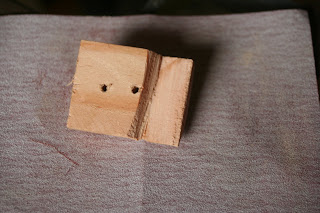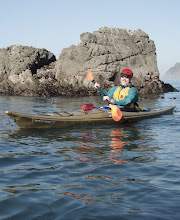After stripping the hull, it was time to fair (make the surface regular) and sand. In concept its pretty simple -- make the hull shaped like it is supposed to be shaped, and make it smooth. In practice, its not rocket science either.
The steps:
- Use a cabinet scraper to scrape all the glue blotches off.
- Use a plane and a cabinet scraper to pare down the prominent ridges where strips meet. (be careful, planing can be mesmerizing and you don't want to go through the hull!)
- Use a fairing board, which is nothing more than sandpaper glued onto a plywood board with handles, to fair the surface.
- Use sandpaper wrapped around spongy foam to fair and smooth concave areas.
- Wet out and sand smooth again. This is the time to search for glue spots that escaped the fairing and sanding so that they don't make an ugly appearance when it is too late to do anything about it (i.e. after epoxy and fiberglass).
One big lesson I learned on this is to use good sandpaper. I used cheap sandpaper for most of the fairing and it took me two or three times as long as it would have with the good stuff.
For the sanding, I used a random orbital sander. This power tool is now one of my best friends. I got one that I could hook a vacuum to and it reduced the dust by about 95%.
BE SURE TO WEAR A DUST MASK!
A few photos to show off my astounding work:
This is the fairing board I made. The handles are angled on purpose, as I find my wrists get sore if I use handles that are vertical. The board is the size of 1/2 sheet of sandpaper, which can be glued on with spray adhesive. Ideally, the fairing board will flex so that it rounds the shape of the boat. I will use thinner plywood next time so that the board flexes.
Looking at the hull from the stern. One half is wetted out to raise the grain, the other half isn't. Can you guess which is which? I thought you could. (In case you couldn't, the right side is wetted out.)
Most of the hull viewed from the bow. The book matching shows up really well here. The board I used for strips had more sapwood (light) at one end and more heartwood (dark) at the other. I laid the strips so that the bow would be lighter and the stern darker. That shows up a little in this picture. I'm hoping it is apparent when the boat is complete.
Detail of the bow. If you look close, you can see that not only did I book match the strips centered around the keel line (see photos above) but also between pairs of strips on one side. The effect is subtle, but I hope it is apparent when the boat is finished.












